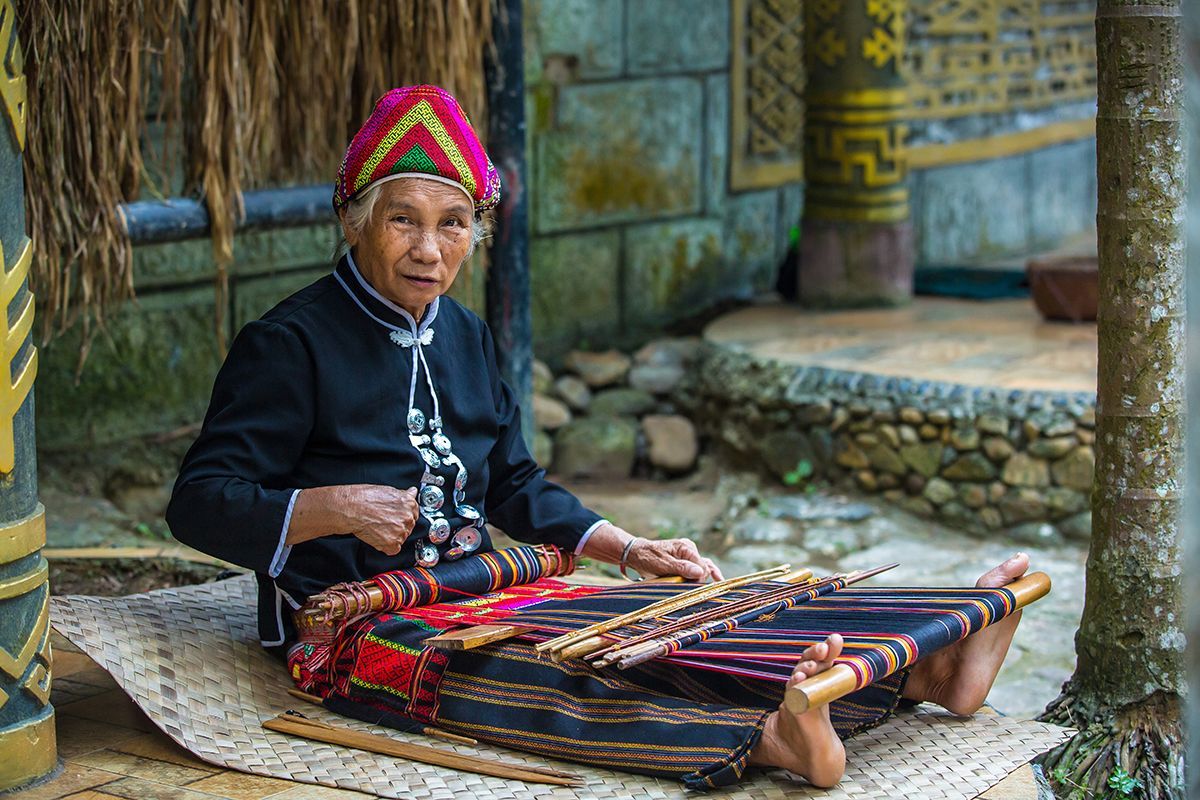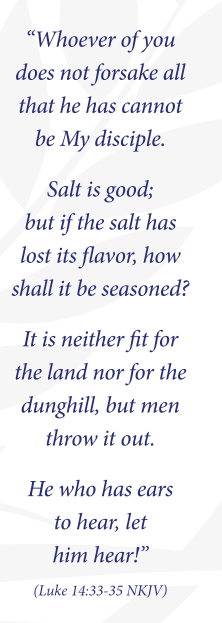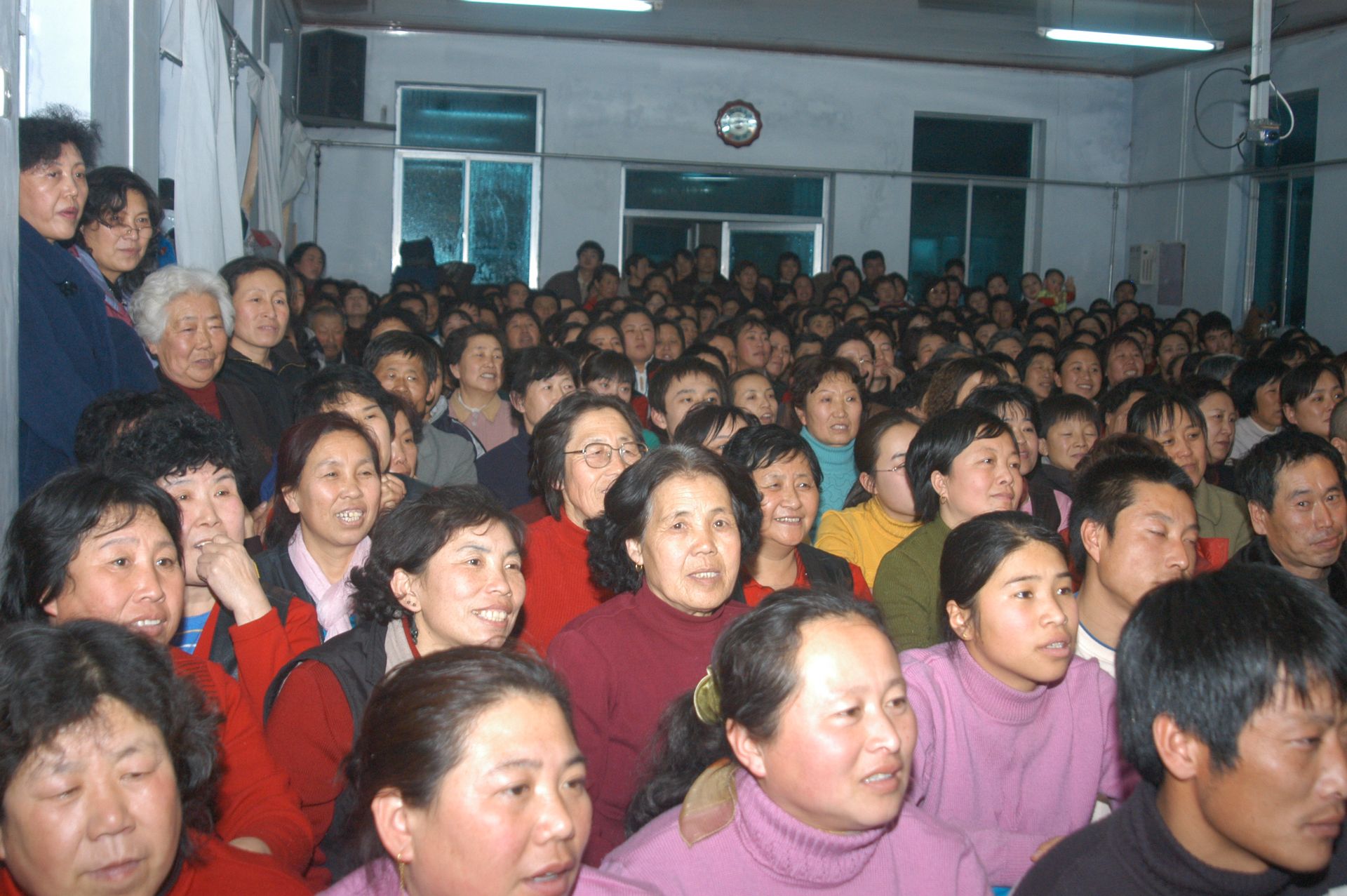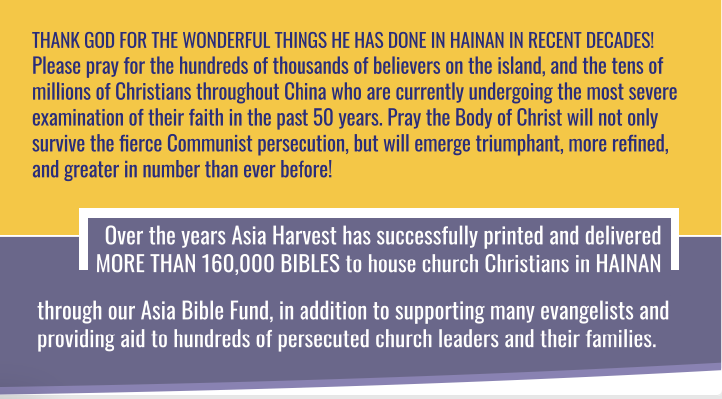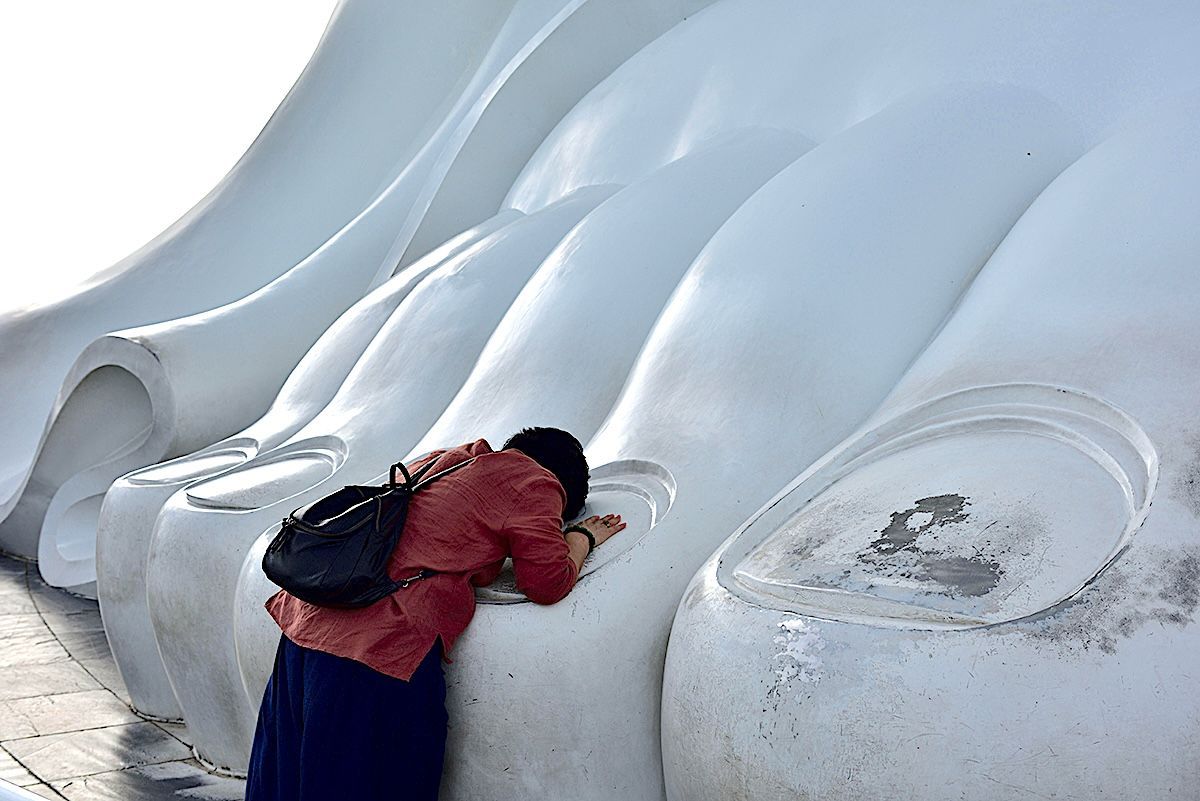A woman from the one of the five Li tribes, who are the original inhabitants of Hainan Island. Is featured in the above photo weaving.
Genuine revival does not come to Christians with a comfortable "country club" type of faith, but it is a boost of ammunition for soldiers on the frontline who are waging war against Satan's forces, risking their lives to see God glorified in their society.
In the remainder of this newsletter, we will share portions from our new book
"Hainan: Pearl of the South China Sea."
As you read about some of the ways the Holy Spirit has shaken Hainan since the 1990s (resulting in more than half a million people coming to faith), honestly ask yourself these questions if you would like to see similar results come to your country and church....
- Would you be willing to be debased and humbled under the hand of God for many years?
- Are you willing to endure extreme hardship, suffering, imprisonment, and possibly death for the Name of Jesus Christ?
- Would you agree for all visible representations of your faith – church buildings, pastors, meetings, musical instruments, even your Bibles – to be taken away so all you have left to cling to is Jesus? And to keep clinging to Him for years or even decades?
- After being revived, would you agree to zealously go wherever He says and so whatever it takes to reach the lost in your nation and beyond?
In short, many want the thrill of living a resurrected life of revival, miracles, and God's mighty power, but few want to experience the crucified life first. But no resurrection is possible without there first being a crucifixion.
This, dear friends, is the secret of the revival in China. Do you still want to share in their experiences?
In this newsletter we are pleased to announce the eighth book in our series on the mighty revival that has swept China during the past 50 years. The China Chronicles are proving to be a great encouragement and are enriching the lives of those who read them.
Hainan is a small tropical island province situated off China’s southern coast. Once nicknamed ‘The Gateway to Hell,’ Hainan had few Christians until the 1990s, when God sent a powerful revival which touched every part of society there. Today, Hainan is home to more than 600,000 vibrant Christians.
Learn how the Lord Jesus Christ established His kingdom in Hainan, and the surprising vessels and strategies He chose to impact the island.
The growth of the Church in Hainan did not come without intense struggle, with many believers suffering for their faith.
The fire of the Holy Spirit fell here with great power, and subsequently the book contains numerous firsthand accounts of ‘power encounters’ against the forces of darkness which transformed entire communities.
The remainder of this newsletter has more excerpts from
‘HAINAN: Pearl of the South China Sea.”
You can order a paperback
or digital copy of the book
here.
When Heaven Came to Hainan
One of the main characteristics of the revival in Hainan during the 1990s and beyond was simplicity. The Christians involved with the movement were determined to implement biblical Christianity. For that to happen, they carefully studied the Scriptures and found that countless beliefs and practices of churches around the world are not based on the New Testament pattern of church life, but are man-made traditions and denominational rules.
These may have an appearance of godliness, but in reality they prohibit the flow of the Holy Spirit and result in dead formalism and legalism, instead of rivers of living water flowing out from the Body of Christ to the communities they serve.
Before the Hainan revival commenced, a decision was made to strip away all non-essential religious forms. There would be no distinction between clergy and “lay” Christians, and each child of God was to be a soul-winner and disciple-maker. All believers had an important role to play, and their diverse spiritual gifts would benefit the whole Body of Christ.
Crucially, those who were already engaged in “fulltime ministry” for Christ were not moved to the side or pushed down. Rather, everyone was raised up so that all Christians, from the youngest to the oldest, were fulltime ministers of the gospel. The tendency for such roles to be performed by a special class of Christian was discarded.
Because almost all converts in the Hainan revival came from a non-Christian background, they had no “baggage” from prior church experiences. As far as they were concerned, the pattern of Christian life they experienced was normal, and they assumed that Christians around the world all lived and worshipped God the same way.
The results in Hainan were astonishing, as God had a blank canvas upon which to paint a masterpiece. He did so, transforming hundreds of thousands of lives in every segment of Hainan society.
The training process that helped spur the revival began with just three house churches, totaling less than 100 members. As the leaders were trained to evangelize the lost, they were encouraged to focus on the neediest areas of the island where there were no existing churches.
An important principle that created a springboard for the Hainan revival was ‘shared leadership’ (i.e., leaders were not allowed to become dictators to their flocks, but were required to practice mutual accountability). In this way, each fellowship remained healthy because of the input of new ideas, fresh teaching, and the balanced acceptance of different spiritual gifts.
Teaching was imparted in such a way that poorly educated and illiterate people did not feel left behind. Leaders were required to be unpaid volunteers, and meetings were held in believers’ homes rather than church buildings. Consequently, despite believers’ meagre salaries, money was available to send evangelists and church planters throughout the island, while the financial needs of church members were also met.
The love Christians had for one another, and for non-believers, was a powerful testimony to the people of Hainan. God’s children even shared their financial resources with strangers in need — something rarely seen in modern, materialistic China. This stark contrast and display of selflessness attracted thousands of people to the Lord.
When a household displayed an interest or had already accepted Christ, their family members and friends were invited to attend Bible studies. In this way, the base of interested people grew ever wider. After a few weeks of simple witness, an invitation was given for people to believe. Those who decided for Christ immediately joined a basic discipleship program which lasted a few weeks. Upon completion of the program, the new believers were baptized.
Church planters identified which of the new converts were potential leaders, after taking careful note of each person’s integrity, character, and hunger for God’s Word. Soon, all public meetings were turned over to them. By appointing multiple leaders, the churches grew without excessive outside influence, and a leadership vacuum was prevented should one or two leaders be arrested.
The evangelists, meanwhile, stayed behind to mentor the new leaders, advising them how to deal with problems in the church, and teaching them God’s Word, which they immediately re-taught to new believers. Subsequently, the movement was completely localized and grew naturally. Because the church leaders were already known and respected in their communities, the Name of Jesus was revered and accepted as a positive influence. Critics could never charge that Christianity was a Western religion, because the movement was completely led and funded by local people.
After a house church had become firmly established, it was required to divide into smaller groups, according to the security concerns in each area. In cities and towns, house groups never exceeded 30 members, although in rural areas where the police presence was less threatening, congregations often grew to hundreds of believers.
Most churches met twice a week; including once on Sunday when non-believers were welcome to attend. An additional mid-week service, held exclusively for Christians, concentrated on discipleship, training, and receiving strategies from God.
House church leaders in each county gathered on the first day of every month for a day of prayer, fasting, and training, while on the 15th day of every month church leaders throughout the entire province gathered in one place for unified prayer and fasting.
The power of God began to transform many parts of the island like wildfire. At the height of the revival, the approximate doubling time for Christians in Hainan was seven months. That is, every seven months the number of believers doubled!
Vision and responsibility for the completion of the Great Commission was extensively taught in the new churches. All trainers and leaders were consumed with the task of reaching the lost, and on-the-job evangelism and discipleship was at the heart of everything they did.
The rapid advance of the Gospel did not occur without great opposition, however, and soon some of the new believers in Hainan experienced the blessing of laying down their lives for Jesus....
Photo Above: A Kim Mun tribal woman from the mountainous interior of Hainan.
Little Wang
In 1994, a small group of three Christian men traveled to an unreached Li tribal area to share the Gospel, but things did not go to plan. The team consisted of Old Wang, his son Little Wang, and their colleague Cai Wen. A report by a Christian worker in Hainan detailed their dramatic story:
“Old Wang winced in pain as the creaking bus bounced along the dirt road. His broken ribs gave him excruciating pain, but he was better off than his co-worker Cai Wen. He looked at Cai, weak from blood loss, who had his eyes closed and was cradling a broken arm.
Wang wasn’t eager to get home, because he had to face Little Wang’s wife, Liang, and her 10-year-old son. He wondered how he would break the news to her that her husband had been murdered by an angry mob of Li people the previous evening. He could still hear the mob’s accusations: ‘The spirits of the mountains rule our land. You Chinese dogs have only been here 500 years and you know nothing. You have stolen our land and now you wish to steal our gods as well. You will pay for this!’
The mob beat the evangelists with sticks and farm implements. A particularly fierce young man continued to beat Little Wang, and when the crowd dispersed, Little Wang didn’t move. He had paid the ultimate price. He and his family had only believed in Jesus Christ for five months.”
After letting them recover from their injuries for a few weeks, the church decided to send Old Wang and Cai Wen back to the same village to preach again.
There were no churches in the entire county, and someone had to take the message of salvation to the Li people. The gathered believers grew silent when the newly-widowed Liang spoke up and requested to accompany Old Wang and Cai Wen on their return trip.
The Christians worshipped for hours that day, praying fervently for the trip and for the salvation of the Li. House churches in other parts of the county were also notified to pray and fast for three days. A report of their courageous return journey said:
“The sun had already set when the trio reached their destination, and they slept beside a pigpen outside the village. Whether due to discomfort or busy minds, none of them slept well that night. The next morning, they went to the market. Word quickly spread of their return, and as a mob formed some people began to yell threats.
Old Wang felt fear sweep over him. Suddenly, Liang stepped forward and spoke:
“I am the widow of the man you killed less than three weeks ago. My husband is not dead, however, because Jesus Christ has given him eternal life. Now he is living in paradise with God forever! My husband came here to share how you can have that same eternal life. If he was here, he would forgive you for what you did. I forgive you as well. I can forgive you because God has forgiven me. If you would like to hear more about our God, then meet us under the big tree outside the village this evening.”
Old Wang spent the afternoon instructing Liang what to say that night. At sunset, most of the villagers gathered under the big tree to listen to her.
After hearing the Good News of God’s salvation, many Li people decided to follow Jesus Christ. Old Wang stayed behind to baptize them and to teach them how to serve God, while Cai Wen accompanied Liang on the long bus journey home.
Two months later, Old Wang returned home with two leaders and a young man from the new Li church. During the Sunday service, the young man stood up and said:
“I am the man who murdered Little Wang. The Lord has graciously forgiven me, and I ask for your forgiveness as well. I, and our entire church, owe an eternal debt of gratitude to Little Wang and Liang for bringing us the message of life. We want to give a monthly love offering to help support Liang and her son. This is the least we can do to show our appreciation.”
Several months later, news emerged from the mountains that the new Li fellowship had planted another church in the same county.

